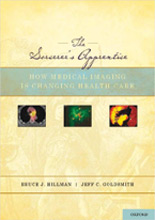
IRIS login | Reed College home Volume 90, No. 1: March 2011
Reediana
Jeff Goldsmith ’70 and Bruce Hillman
The Sorcerer’s Apprentice: How Medical Imaging is Changing Health Care (Oxford University Press, 2010)
By Chris Lydgate ’90

“Medical imaging” is a decidedly unglamorous phrase. Yet the technology it refers to—the ability to peer inside the human body without having to cut that body open—represents one of the greatest achievements in history. In this provocative book, the authors examine the advent of imaging in its myriad forms (X-ray, ultrasound, CT scan, etc.) and how it is transforming both the practice and the business of medicine.
And, make no mistake about the “business” part. With a staggering 687 million imaging procedures performed in the U.S. each year, at an annual cost of $170 billion, imaging has become a key medical profit center.
Jeff and co-author Bruce Hillman chart the complex forces driving the phenomenal growth of imaging, from arcane Medicare rules to self-interested physicians (some of whom earn lucrative fees for sending patients to the scanner) to the fear of malpractice lawsuits. But the real culprit, they conclude, is more fundamental: our collective discomfort with ambiguity, or as the authors put it, “the impossible quest for medical certainty.”
The book abounds with fascinating historical anecdotes. You probably remember (at least the fuzzy outlines of) Wilhelm Röntgen’s remarkable discovery of X-rays in 1895. But did you know that the Beatles were indirectly responsible for the first CT scanner? (Flush with cash, their label EMI backed an unlikely innovator, whose primitive equipment required nine hours to make a scan.)
The book’s real contribution, however, is its careful examination of the conflicts this amazing technology has generated. Some of these conflicts, such as the turf war between radiologists and oncologists, are primarily of interest to specialists. Others, such as the debate over using CT scans to screen smokers for lung cancer, illuminate the twisted workings of modern medicine.


LATEST COMMENTS
steve-jobs-1976 I knew Steve Jobs when he was on the second floor of Quincy. (Fall...
Utnapishtim - 2 weeks ago
Prof. Mason Drukman [political science 1964–70] This is gold, pure gold. God bless, Prof. Drukman.
puredog - 1 month ago
virginia-davis-1965 Such a good friend & compatriot in the day of Satyricon...
czarchasm - 4 months ago
John Peara Baba 1990 John died of a broken heart from losing his mom and then his...
kodachrome - 7 months ago
Carol Sawyer 1962 Who wrote this obit? I'm writing something about Carol Sawyer...
MsLaurie Pepper - 8 months ago
William W. Wissman MAT 1969 ...and THREE sisters. Sabra, the oldest, Mary, the middle, and...
riclf - 10 months ago